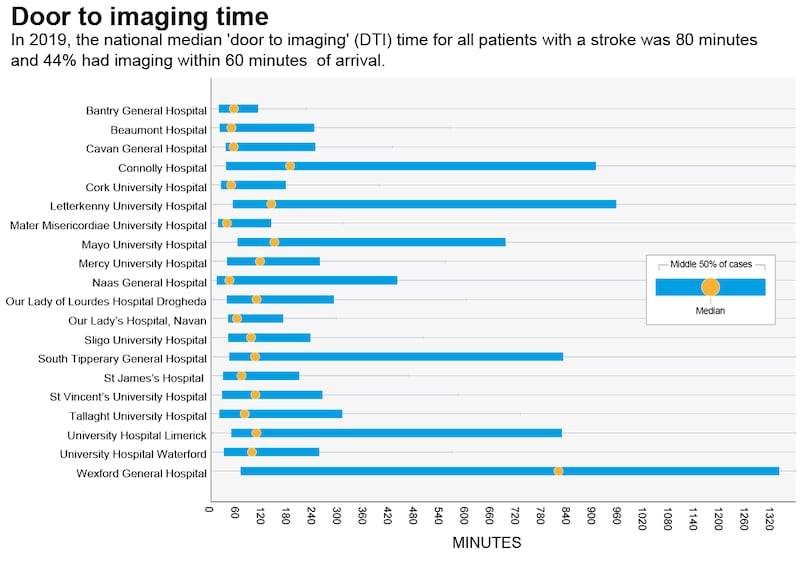Less than half of all patients suffering from stroke present to hospital quickly enough to receive emergency treatments, a new report reveals.
Large variations between different hospitals in the time taken to treat patients are also evident in the 2019 national audit of stroke services.
Stroke patients are supposed to be scanned within an hour of arriving in hospital, but in 14 out of 20 hospitals this target was not reached. In Wexford General Hospital, the average “door to imaging” time was almost 14 hours, compared with one hour and 20 minutes across all hospitals.
Just 49 per cent of patients arrived in hospital within three hours of the onset of their stroke symptoms, down from 53 per cent in 2017, according to the report. This means they are less likely to receive potentially life-saving “clot-busting” treatments.

The audit shows most patients are left with a disability after a stroke – 72 per cent in the case of ischaemic stroke and 62 per cent for haemorrhagic stroke. Only one in 20 patients is well enough to be referred for early supported discharge.
Ischaemic stroke, accounting for 85 per cent of all strokes, happens when the brain’s blood vessels become blocked. Haemorrhagic stroke results from ruptured or leaking blood vessels.
The death rate for ischaemic stroke is 9 per cent – half what it was in 2008 – while for haemorrhagic stroke it is 31 per cent.
Thrombolysis, the use of drugs to break down blood clots formed in blood vessels, must be given with 4½ hours of the onset of stroke. Last year just 10.6 per cent of patients with ischaemic stroke received this treatment, down slightly on 2018.
Another procedure, thrombectomy, involving the removal of large clots from the arteries of the brain, was performed on 9 per cent of stroke patients. The rate in Europe is 2 per cent.
Stroke units
The average time to get a stroke patient from arrival at hospital to contact with the medical team was 17 minutes, the audit found.
Some 71 per cent of patients were admitted to a dedicated stroke unit, well below the target of 90 per cent. The main reasons for not admitting a patient to a stroke unit were lack of capacity, with no stroke unit bed available in 38 per cent of cases; and lack of a stroke unit, as 20 per cent of hospitals do not have one.
Stroke is the third leading cause of death in Ireland and western Europe, and the leading cause of severe physical disability occurring in adulthood.
The average age of patients with a stroke was 72, though 24 per cent were under 65.
Prof Joe Harbison, clinical lead on the Irish National Audit of Stroke, said the report would help services review quality and allow for improvements. “This audit points to the need for investment in more designated stroke unit beds to meet our key performance indicators. It also highlights the need for patients to go to hospital as soon as possible when experiencing stroke symptoms.”










